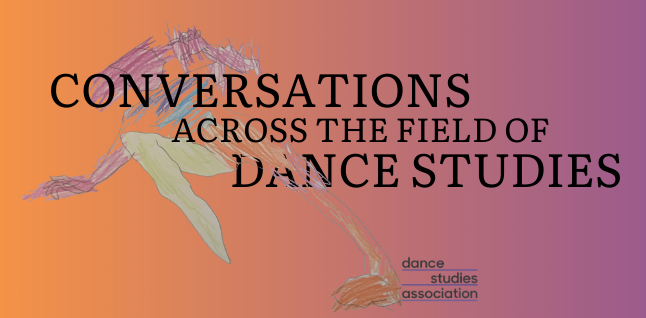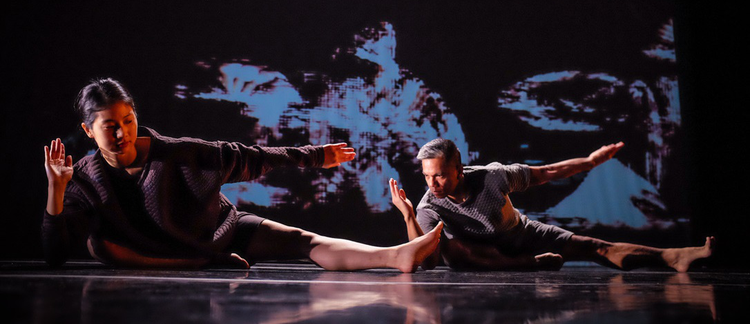here now here, by Li Chiao-Ping (2019)
He feels the color of the bumpy and fizzy drops of feathers on top of his angular and sharp frame. His body, disgusted and protesting the invasion of smells.
She, hardly fazed by numerical setbacks, seismic as they may seem, breathes in the droplets jabbing at her.
Barely there. Bodily here.
A dream, drowning. Murky waters. Black abyss. Covered. Unseen.
Here I am.
Tell me how you really feel.
What are you doing? Nothing.
How are you? Fine.
Everything ok? Yes.
Here I am.
You’re wrong.
Stop.
Go back.
I live in fear.
I live in the shadows, under cover, hiding, illegal, alien, other
You see my color my skin
You see my gender my body
You think you know me
I am here.
You are there.
I am not there.
Can we both be here? Or there?
Tied together
Start again. Go backwards.
How did you get here?
I was
Floating
The moment you dreamed of
###
Just prior to the pandemic, in the fall of 2019, I wrote the above text for a duet I was choreographing titled here n o w here. At the time, I was experimenting with ways to compose and present dance-based performances around identity(ies) and opacity, and ideas of presence and being seen. Besides being a stand-alone work, here n o w here is also now embedded within the 55-minute multimedia dance performance Here Lies the Truth,1 which I premiered in 2022. As the second to last section of the entire show, this duet brings us back to a human level, looking at us as similar and complex individuals. As the dancers undress at the end of the duet, I propose we look at their common humanity, their sameness. The balance of the two dancers, working in harmony, presents a hopeful vision for how we might be able to see one another.
I began the work on Here Lies the Truth in summer 2020. I set out to explore fact and fiction, questions about truth and lies, and how these questions infiltrate the personal and political environments we experience. Events at that time, from the 2016 and 2020 presidential elections and the use of such terms as “fake news” and “alternative facts,” to hate and violence against people of color, women, LGBTQ+, and other marginalized groups, were bringing into focus how people in power abuse their power in ways that can change our physical, mental, and emotional landscapes.
The first iteration of Here Lies the Truth was shown as a Zoom performance on August 14–15, 2020. It was done live and I made inventive use of the various features of Zoom. On April 1, 2021, we showed Here Lies the Truth, part ii, but this time the work took place as a screendance work shared over Vimeo. On July 31, 2021, we made Here Lies the Truth, part iii, which we performed before a live audience. I wrote This Is a Dog in the summer of 2021, after I had choreographed a long accumulation section made mostly of gestural material. I had had conversations with my dramaturg, Cláudia Tatinge Nascimento, about how we would collaborate, as well as about our different thoughts on what I had already created in parts i and ii, which she had seen (via Zoom and Vimeo). What were the other truths that we would talk about in this iteration? For the new full-evening version of Here Lies the Truth, we needed to talk about race.
This is a Dog, by Li Chiao-Ping (2021) This is me and mine, not you and yours, or them and they Except that me is they And we is they, too, ok? So, let’s say…
This is A dog This is a dog with a box A huge box on top of a rock The size of Rushmore Wearing socks
This is a bubble This is a dog and a boy who boxes in a bubble Seeing trouble, trouble seeing Tumbling bubbles and tired troubled couples
This is a donkey who kickboxes in that bubble Elephants, in the room, aren’t shy, want to rumble? Paper, scissors and rocks Determining winners, making bets, on game-changing stocks These rocks, the size of Rushmore, are jagged and rise high
This is… And, This is … a high rise A high rise rising high Is this the house that Jack built?
This is a tumor, just a rumor A tale of Chasing a dog in a troubled bubble Of chasing the cat that chased the rat
The dog with a box of rocks worried the cat And chased the rat who stole her socks, That reached up to her knees That ate the cheese but never asked please
Stretched and worn, the pages are torn The story is careless and reckless, Precarious on stilts Is this the house that Jack built?
From March 25 to 26, 2022, we premiered the full multimedia dance performance production in person and before a live audience. As initially proposed to the National Endowment for the Arts back in early 2020, Here Lies the Truth was to be a collaboration among myself, Cláudia, and visual artist Douglas Rosenberg, but it wasn’t until summer 2021 that we were able to begin more significant conversations on the work’s direction. Looking back at its trajectory, the various parts of the whole were the means through which I was able to begin facing the traumas experienced by BIPOC communities, including, for example, long histories and repeated acts of hate, violent attacks, erasure (of contributions, existence, significance/value), colonization, white supremacist ideology, and systemic and institutionalized racism. Each of my choreographic experiments allowed me to spend time and refine how I would synthesize and represent a kinetic/visual/aural landscape of inequity, bias, prejudice, and discrimination, as a way to give witness to these oppressions. The sum of these processes allowed me to have conversations with my collaborators about casting, format, aesthetics, messaging, and more.
I am honored to contribute to this issue of Conversations. I am in progress, as is Here Lies the Truth.
As a first-generation Chinese American woman who grew up in San Francisco, I dutifully followed what had been prescribed to me by my parents and society: to assimilate and not make a fuss or raise my voice.
However, these past few years of accumulated racial traumas, from the attacks on Asians (the murders of six Asian women in Atlanta in 2021 and the assaults on Asian elders on the East and West coasts) and Black people (too many to name, including George Floyd, Ahmaud Arbery, and Breonna Taylor), on top of the overwhelming number of examples of how BIPOC folks are perceived and (not) valued, including the racially motivated murder of Vincent Chin by two white men 40 years ago, which resulted in no jail time and only a $3,000 fine, have forced me to see the real and ugly truth.
I see so much work to do and am feeling conflicted with everyone and everything. I find myself exhausted yet inspired. I see many new voices and models rising up, which give me hope for the future. My son Jacob Li Dai-Loong Rosenberg, who is Chinese-Jewish American, is part of a generation that gives me hope. Some of Jacob’s photographs are featured and projected in Here Lies the Truth. (Performance documentation photos were taken by Jacob Li Rosenberg and Caitri Quirk.)
I put in him the hopes my parents put in me, which were wishes for my life not to be as hard as theirs was. I hope he will not feel invisible, erased, or minimized, or suffer from the repeated traumas due to conditional belonging/inclusion or other supremacist thinking and actions.
I have more resolve and less doubt that I must use my voice to contribute to a better future where equity, diversity, mutual respect, and inclusion are given.
This is Here Lies the Truth.
Notes
- Here Lies the Truth credits: Concept/Direction - Li Chiao-Ping; Choreography - Li Chiao-Ping in collaboration with the dancers; Collaborator/Dramaturg/Vocal Coaching - Cláudia Tatinge Nascimento; Collaborator/Visual Design - Douglas Rosenberg with design assistant Hong Huo; Other Images - Jacob Li Rosenberg; Collaborator/Sound Designer - Tim Russell with other music noted in the program; Texts - JP Alejandro, Alfonso Cervera, Kimi Evelyn, Li Chiao-Ping, Douglas Rosenberg, Elisabeth Roskopf, Abbi Stickels, Cláudia Tatinge Nascimento, and verbatim transcriptions of legal and journalistic testimonies; Lighting Design - John Frautschy; Costumes - Li Chiao-Ping with costume assistant Veda Manly; and Dancers - JP Alejandro, Alfonso Cervera, Kimi Evelyn, Piper Morgan Hayes, Elisa Hildner, Cassie Last, Elisabeth Roskopf, Mariel Schneider, Abbi Stickels, with Li Chiao-Ping. ⮭
Author Biography
Li Chiao-Ping, one of Dance Magazine’s “25 to watch,” earned her graduate degree from the University of California, Los Angeles, and was the Director of the Hollins College Dance Program (1989–1993) and Chair of the University of Wisconsin–Madison Dance Department (2011–2014). She is the artistic director of Li Chiao-Ping Dance and has directed/choreographed in musical theater, opera, and ballet, for stage, screen, and other sites; she receives commissions from dance companies, colleges/universities, and individuals around the country. A four-time National Endowment for the Arts (NEA) grant awardee and MAP Fund grant recipient, she has also received fellowships from the Wisconsin Arts Board and Scripps/ADF Humphrey-Weidman-Limon. She was the American representative in ADF’s International Choreographer’s Program and was honored with an Outstanding Woman of Color in Education Award. Her work has been praised in the New York Times, Village Voice, Dance Magazine, Los Angeles Times, Washington Post, and San Francisco Bay Guardian and shown in major venues/festivals in the United States and abroad, including Jacob’s Pillow, Bates, ADF, Kennedy Center, Walker Art Center, Dance Place, Danspace Project, DTW, Theater Artaud, CounterPULSE, as well as in Canada, Mexico, Taiwan, Argentina, and more. She is honored to be a UW-Madison Vilas Research Professor and the Sally Banes Professor of Dance, the first person in Dance to receive either professorship.











